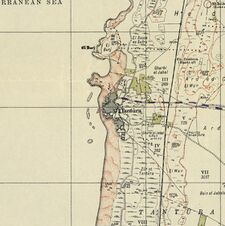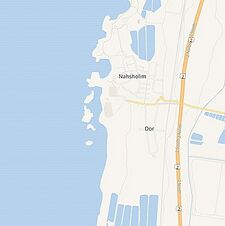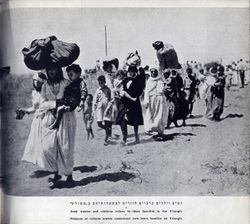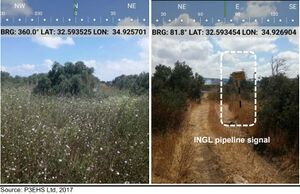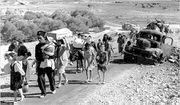الطنطورة (حيفا)
Tantura
الطنطورة al-Tantura | |
|---|---|
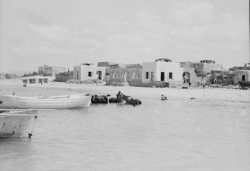 Tantura (1920-1933) during the British Mandate | |
| أصل الاسم: "The Peak"[1] | |
A series of historical maps of the area around Tantura (click the buttons) | |
Location within Mandatory Palestine | |
| الإحداثيات: 32°36′34″N 34°55′04″E / 32.60944°N 34.91778°E | |
| Palestine grid | 142/224 |
| الكيان الجيوسياسي | فلسطين الانتدابية |
| منطقة فرعية | حيفا |
| Date of depopulation | 23 مايو 1948[3] |
| المساحة | |
| • الإجمالي | 14٫25 كم² (5٫50 ميل²) |
| التعداد (1945) | |
| • الإجمالي | 1٬490[2] |
| سبب هجرة السكان | الطرد بواسطة قوات ييشوف |
| المحليات الحالية | نحشوليم,[4]Dor[5] |
الطنطورة (al-Tantura, lit. The Peak; Hebrew and Phoenician: דור, Dor)[6]كانت قرية صيد عربية فلسطينية تقع على بعد 8 كيلومترات (5 ميل) شمال غرب زخرون يعقوب[7] تقع الي الجنوب من مدينة حيفا، وتبعد عنها 24 كم وترتفع 25 كم عن سطح البحر، وتقوم القرية علي بقايا قرية (دور) الكنعانية وتعني المسكن.
على ساحل البحر الأبيض المتوسط لإسرائيل. بالقرب من القرية، تقع أطلال مدينة دور الفينيقية القديمة.[8]
كانت القرية تقع على تل منخفض من الحجر الجيري يطل على شاطئ خليجين صغيرين.[9] وكانت المياه تأتي من بئر تقع في الجزء الشرقي من القرية.[9] وكانت بوابة الباب تقع إلى الجنوب الشرقي من القرية. وكانت الآثار الرومانية على الساحل من الشمال حتى تلة أم رشيد من الجنوب.[10] تبلغ مساحة أراضيها 14520 دونما وتحيط بها قري كفر لام والفريديس وعين غزال وجسر الزرقاء وكبارة. قدر عدد سكانها سنة 1929 حوالي 750 نسمة وفي عام 1945 حوالي 1490 نسمة.
قامت المنظمات الصهيونية المسلحة بهدم القرية وتشريد أهلها البالغ عددهم عام 1948 حوالي 1728 نسمة وكان ذلك في 23 مايو 1948، وعلي أنقاضها أقيمت مستعمرة نحشوليم عام 1948 ومستعمرة دور عام 1949.
تم استهداف القرية في المراحل الأولى من الحرب العربية الإسرائيلية عام 1948، حيث نُهبت منازلها وطرد سكانها العرب الفلسطينيون وذبح آخرون على يد البالماخ السرى الإسكندروني. تم توثيق مذبحة الطنطورة لأول مرة من قبل سياسي فلسطيني في عام 1951، قبل عقود من كشف فيلم وثائقي إسرائيلي عام 2022 عن شهادة من العديد من قدامى المحاربين في جيش الدفاع الإسرائيلي تؤكد وقوع مذبحة، شارك فيها ما بين عدة إلى 200 ضحية فلسطينية، في ذلك الوقت.[11]
. . . . . . . . . . . . . . . . . . . . . . . . . . . . . . . . . . . . . . . . . . . . . . . . . . . . . . . . . . . . . . . . . . . . . . . . . . . . . . . . . . . . . . . . . . . . . . . . . . . . . . . . . . . . . . . . . . . . . . . . . . . . . . . . . . . . . . . . . . . . . . . . . . . . . . . . . . . . . . . . . . . . . . . .
مذبحة الطنطورة
 مقالة مفصلة: مذبحة الطنطورة
مقالة مفصلة: مذبحة الطنطورة
أكد عدد من المؤرخين العرب واليهود أن مجزرة الطنطورة تعتبر أبشع المجازر التي ارتكبتها الصهيونية في فلسطين والبالغة نحو ثمانين مجزرة. كانت وحدة ألكسندروني في الجيش الإسرائيلي قد اقترفت في 23 مايو 1948 المجزرة بحق أهالي قرية الطنطورة قضاء حيفا غداة احتلالها، وقامت بتهجير السكان للضفة الغربية والأردن وسوريا والعراق ولبنان.
ويشير المؤرخ مصطفى كبها إلى أن الجيش الإسرائيلي اختار الهجوم على قرية الطنطورة -التي بلغ عدد سكانها 1500 نسمة- كونها الخاصرة الأضعف ضمن المنطقة الجنوبية لحيفا، بسبب موقعها على ساحل البحر المتوسط ولكونها سهلة الاحتلال بعكس سائر القرى المجاورة على قمم جبل الكرمل.
وأشار كبها إلى أن الجيش الإسرائيلي استهدف القرية في ليلة الـ22 من مايو بقصفها من البحر قبل مداهمتها من جهة الشرق في نفس الليلة. اختار جيش الاحتلال الطنطورة بالذات لا لسهولة مهاجمتها فحسب بل لكونها مرفأ كان يصل منه السلاح للفلسطينيين. وقال "تركت المجزرة في الطنطورة أثرا بالغا على الفلسطينيين في القرى المجاورة ومهدت لتهجيرهم".
وفي المقابل أكد المؤرخ الإسرائيلي تدي كاتس -الذي تعرض لدعوى تشهير من قبل وحدة ألكسندروني بعد كشفه عن ملابسات المجزرة في الطنطورة بدراسة ماجستير في جامعة حيفا عام 1998- أن الشهادات التي حاز عليها تشير لسقوط 230 فلسطيني في المجزرة.
وأوضح كاتس -الذي سحبت جامعة حيفا اعترافها برسالته الأكاديمية بعد الضجة الإعلامية التي أثارها الكشف عنها وقتذاك- أن موتي سوكلر حارس الحقول اليهودي في تلك الفترة قد كلف من الجيش الإسرائيلي بتولي دفن الموتى موضحا أنه كان قد أحصى الضحايا بعد قتلهم على شاطئ البحر وداخل المقبرة.
ومن جهته اعتبر المؤرخ إيلان بابه أن خطورة مجزرة الطنطورة واختلافها عن سائر المذابح في فلسطين لا يعود فقط لحجم ضحاياها بل لارتكابها على يد جيش إسرائيل بعد أسبوع من إعلان قيام دولة إسرائيل.
وذكر بابه أن مجزرة الطنطورة التي وقعت بعد نحو شهر من مجزرة دير ياسين استهدفت تحقيق الهدف الصهيوني المركزي المتمثل بتطهير البلاد عرقيا بقوة السلاح وترهيب المدنيين وتهجيرهم.
ويؤكد الحاج فوزي محمود أحمد طنجي، أحد الناجين من المجزرة والمقيم حاليا في مخيم طولكرم أن قشعريرة تجتاحه كلما يتذكر كيف ذبح أبناء عائلته وأصدقاؤه أمام ناظريه. وروى طنجي، الذي دخل عقده الثامن، أن أبناء القرية دافعوا بشرف عنها منذ منتصف الليل حتى نفذت ذخيرتهم في الصباح.
وروى طنجي أن الجيش فصل بين الرجال ممن أجبروا على الركوع وبين النساء والأطفال والشيوخ، مشيرا إلى أن أحد الجنود حاول الاعتداء على فتاة من عائلة الجابي، فنهض أبوها لنجدتها فقتلوه طعنا بالحراب، بينما واصل الجنود تفتيش النساء وسرقة ما لديهن من حلي ومجوهرات وقاموا بترحيل الجزء الأكبر منهم إلى الفريديس.
ويستذكر طنجي أنه في الطريق للبيت بحثا عن السلاح أطلق الجنود المرافقون له النار على سليم أبو الشكر (75 عاما).
وقال "عندما وصلنا البيت كان الباب مقفلا، والدماء تسيل من تحت الباب، فخلت أنهم قتلوا أمي فدخلت ودموعي على خدي فوجدت كلبي مقتولا، ولم أجد أمي فقلت لهم لا أعلم أين أخفت أمي السلاح، فدفعني أحد الجنود وأرجعوني نحو الشاطئ وفي الطريق أطلقوا الرصاص على السيدتين عزة الحاج ووضحة الحاج".
ويؤكد الناجي من المجزرة أن الجنود صفوا ما يتراوح بين عشرين وثلاثين شابا بالقرب من بيت آل اليحيى وكانت من أكبر عائلات البلد على شاطئ البحر وقتلوهم، ويوضح كيف أمروه وآخرين بحفر خندق بطول أربعين مترا، وبعرض ثلاثة أمتار، وعلى عمق متر واحد، ثم بدؤوا بأخذ ما بين ثمان وعشر رجال لنقل الجثث ورميها بالخندق وعندما حاول فيصل أبو هنا، مقاومتهم، قتلوه بحراب البنادق، وقال "لو عشت ألف سنة لن أنسى ملامح وجوه الجنود فقد بدوا لي كهيئة الموت، وأنا أنتظر دوري متيقنا أنها لحظاتي الأخيرة".
وقد قامت الروائية رضوى عاشور بكتابة رواية تُدعى الطنطورية تناولت فيها قصة فتاة نجت من المجزرة المروعة وتم تنزيحها إلى لبنان بعد ذلك .
القرية اليوم
لم يبق من القرية إلا مقام وقلعة وبئر قديمة وبضعة منازل. أحد المنازل الباقية ( منزل آل اليحيى) بني في سنة 1882. مثلما يتبين من نقش ظاهر عليه. وينتشر كثير من شجر النخيل وبعض نبات الصبار في أنحاء الموقع. الذي تحول إلى منتزه إسرائيلي يضم بعض المسابح.
يوجد الآن مستوطنة دور المبنية على أرض قرية الطنطورة. وفي 2021 كشف انهيار ساحلي عن مقبرة جماعية لمذبحة الطنطورة.
التاريخ
تم اكتشاف العديد من حطام السفن من فترات متعددة في المياه قبالة سواحل.[12]
العصر الحديدي
كانت دور مستوطنة الفينيقيين أقصى الجنوب على ساحل سوريا ومركزًا لصناعة الأرجوان الصوري، المستخرج من حلزون الموركس الموجودة هناك بكثرة.[8] تم ذكر دور لأول مرة في قصة ون آمون المصرية، كميناء يحكمه الأمير تجيكر بيدر، حيث توقف ون آمون (كاهن آمون في الكرنك) في طريقه إلى جبيل وتعرض للسرقة.[13]
مرجع الكتاب المقدس العبري
بحسب سفر يشوع، كانت دور مدينة ملكية قديمة لـ الكنعانيين المسيطرين على المرتفعات، والتي أصبح ملكها حليفًا لـ يابين من حاصور في الصراع مع يشوع(11:1-2; Jos 12:23%20{{{2}}}&verse={{{3}}}&src=! Jos 11:1-2; Jos 12:23 {{{2}}} {{{3}}}). تم ذكر دور أيضًا في سفر القضاة كمدينة كنعانية تم تكليف سكانها "بمهمة" عندما تم تخصيص المنطقة لسبط منسى(Judges 1:27–28 {{{3}}}).في كتاب الملوك، قيل أن دور قد تم دمجه في مملكة داود الإسرائيلية. وفي القرن العاشر قبل الميلاد، أصبحت عاصمة مرتفعات دور في عهد سليمان، وكان يحكمها صهره، بن أبيناداب [13] كواحدة من مناطق مفوضية سليمان (Kings%204:11&verse={{{3}}}&src=! I Kings 4:11 {{{3}}}).[14]
الفترات الهلنستية والرومانية
يصف جوزيفوس فلافيوس في كتابه آثار اليهود (14:333) مدينة دور بأنها ميناء غير مُرضٍ حيث كان يجب نقل البضائع بواسطة الولاعات من السفن في البحر. دورا كانت المدينة التي قام فيها أنطيوخوس، حاكم الإمبراطورية السلوقية الهلنستية بمساعدة سيمون المكابي، بحصار المغتصب تريفون.[15] أثناء غزو بومبي لـ يهودا، تم تدمير دورا، بالإضافة إلى جميع المدن الساحلية، ليتم إعادة بنائها تحت إشراف غابينيوس.[16]
وكانت دور موقعًا مهمًا لإنتاج الملح، كما تشهد على ذلك البرك والقنوات المحفورة على طول الساحل.[17]
وبحلول منتصف القرن الثالث الميلادي، تدهورت المدينة إلى ما يزيد قليلاً عن مجرد قرية لصيد الأسماك.[18]
الفترة البيزنطية
ارتفعت أهمية دور/دورا مرة أخرى من القرن الرابع إلى القرن السابع الميلادي، لتصبح بحلول القرن الخامس مركزًا لـ الأسقفية. تم ذكر العديد من أساقفة الدورة في تلك الفترة في سجلات الكنيسة المسيحية.[19] وهاجرت المستوطنة من التل القديم إلى المنطقة الواقعة شرقه، وتمركزت في مجمع الكنيسة، الذي كان بمثابة محطة طريق لسفر الحجاج إلى الأماكن المقدسة.[18] في الفترة من 1950 إلى 1952، تم التنقيب عن كنيسة بواسطة ليبوفيتز، وفي 1979-1983 بواسطة دوفين، وفي عام 1994 بواسطة جيبسون ودوفين.[18]
أدى التنقيب تحت الماء لحطام بيزنطي إلى إنقاذ قارب متوسط الحجم مبني بمسامير حديدية.[12] بناءً على العملات المعدنية المستردة من الموقع، يعود تاريخ القارب إلى عام 665 م، بعد عقد من الفتح الإسلامي.[12] تشمل القطع الأثرية العديد من الأشياء التي تشهد على ممارسة الصيد الخفيف.[12]
. . . . . . . . . . . . . . . . . . . . . . . . . . . . . . . . . . . . . . . . . . . . . . . . . . . . . . . . . . . . . . . . . . . . . . . . . . . . . . . . . . . . . . . . . . . . . . . . . . . . . . . . . . . . . . . . . . . . . . . . . . . . . . . . . . . . . . . . . . . . . . . . . . . . . . . . . . . . . . . . . . . . . . . .
الفترة الإسلامية المبكرة
من المحتمل أن قرية الطنطورة، الواقعة إلى الجنوب، قد تم إنشاؤها بعد هجر الكنيسة في العصر الإسلامي المبكر.[18] تم التنقيب عن 34 قبرًا إسلاميًا على ما يبدو، يعود تاريخها إلى القرن الثامن إلى القرن الرابع عشر، في منطقة الكنيسة البيزنطية المدمرة.[20]
الفترة الصليبية
في العصور الوسطى، تم بناء حصن صغير محاط بـ خندق على الرعن الجنوبي الغربي للتل، ويطل على مدخل الخليج الجنوبي. تم التعرف على دور مع إمارة ميرل الصليبية، على الرغم من أن الحفريات في الموقع، المعروف باللغة العربية باسم خربة البرج، تشير إلى أن الخندق قد تم حفره لاحقًا، في القرن الثالث عشر.[18]
وظل الحصن في حوزة فرسان الهيكل حتى عام 1187، عندما فتحه السلطان صلاح الدين الأيوبي بعد معركة حطين. استعادها فرسان الهيكل بعد ذلك بوقت قصير، على أبعد تقدير خلال الحملة الصليبية الثالثة. في خريف عام 1191، استراح ريتشارد قلب الأسد هناك مع جيشه أثناء انتظار أسطول عكا. في النهاية، سيطر المماليك على الحصن جنبًا إلى جنب مع قصر بيليرين بحلول عام 1291 أو قبل ذلك.
الكرسي الكاثوليكي الفخري اللاحق للدورة
هناك سجلات للعديد من أساقفة الكرسي اللاتينيين في القرن الرابع عشر والقرن الخامس عشر [19] والتي لا تزال تحت اسم دورا الكرسي الرسولي تابع لـ الكنيسة الكاثوليكية.[21]
الفترة العثمانية
Tantura rose in importance in the mid-18th century with the increased demand for cotton in Europe. Zahir al-Umar carried out a policy of expansion of trade, increasing the capacity of the port at Tantura, as well as those of Haifa and Acre.[22]
Tantura was visited in 1738 by Richard Pococke, who called it "Tortura." He wrote that it was a small village with a port to the south for large boats.[23]
In 1799 when Napoleon Bonaparte besieged Acre, he used the anchorage at Tantura as a supply depot. Napoleon camped at Tantura on May 21, 1799, and a garrison was stationed there for the remainder of the French campaign.[24] Napoleon's officer Lambert, who had been sent to investigate the port, reported that it had a population of about 2,000, who seemed sympathetic to the French.[24] After the failure of his campaign, his troops retreated to Tantura, where he hoped to evacuate by sea, but his navy failed to appear. To free up horses for carrying the wounded, he ordered heavy ordnance dumped in the bay. Artillery pieces, muskets and ammunition have been found in underwater surveys around Dor.[18] It appeared as the village Tantourah on the map that Pierre Jacotin compiled during this campaign.[25]
The British traveller James Silk Buckingham, who visited in 1816, described al-Tantura as a small village with a small port and a khan (caravanserai).[26] Mary Rogers, sister of the British vice-consul in Haifa, reported that in 1855 there were 30–40 houses in the village, with cattle and goats as the chief source of income.[27]
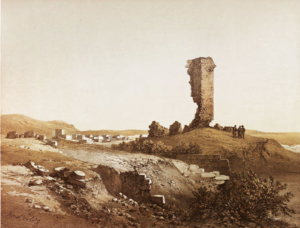
In 1859, William McClure Thomson described Tantura/Dor in his travelogue:
'Tantura merits very little attention. It is a sad and sickly hamlet of wretched huts on a naked sea-beach, with a marshy flat between it and the base of the eastern hills. The sheikh's residence and the public menzûl for travellers are the only respectable houses, Dor never could have been a large city, for there are no remains. The artificial tell, with a fragment of the Kùsr standing like a column upon it, was probably the most ancient site. In front of the present village and five small islets, by the aid of which an artificial harbour could easily be constructed. The entrance to which would be by the inlet at the foot of the Kùsr; and should "Dor and her towns" ever rise again into wealth and importance such a harbour will assuredly be made'.[28]
When Victor Guérin visited in 1870, he found the village to have twelve hundred inhabitants, and further noted that the village itself was built largely with materials taken from the ancient city of Dor.[29]
In 1882, in the PEF's Survey of Western Palestine, Tantura was described as a village on the coast with a harbour located to the north, and a square, stone building used as a guest house for travellers (probably the khan referred to by Buckingham). The population was engaged in agriculture and conducted a small trade with Jaffa.[30]
In 1884 Mordechai Bonstein, a Russian Jewish farmer pioneer from Rosh Pinna, moved to Tantura to farm a tract of land owned by Baron Edmond de Rothschild. Bonstein, his wife Haya, and their nine children were the only Jews in the village. The farm was successful and the family maintained good relations with their Arab neighbours.[31]
A population list from about 1887 showed that Tanturah had about 770 inhabitants, all Muslim.[32] A boys' elementary school was built in Tantura in 1889.[33]
In 1891, Baron Rothschild financed the development of a bottle factory in Tantura,[34] as he planned to use the fine sand on the shore to manufacture glass bottles for the fledgling wine industry in Zikhron Ya'akov.[7] A building was constructed under the supervision of Meir Dizengoff, a French glass specialist was brought in, dozens of workers were hired, and three ships were purchased to transport raw material and bottles. But, he abandoned the factory in 1895 after a string of failures.[7]
In 1898, German Emperor Wilhelm II visited the ruins of the crusader castle.
فترة الانتداب البريطاني
According to the British Mandate's 1922 census of Palestine, al-Tantura had a population of 750 inhabitants; 749 Muslims and 1 Roman Catholic Christian,[35][36] increasing in the 1931 census to 953; 944 Muslims, 8 Christians and 1 Jew.[37] During this period Tantura's houses, situated along the beach, were constructed from stone. In addition to the boys' school, a girls' school was founded in 1937-38.[33] There were two Islamic holy sites in the village, including a maqam (shrine) dedicated to an Abd ar-Rahman Sa'd ad-Din.[38]
During the British Mandate, the fish catch increased from six tons in 1928 to 1,622 tons in 1944. The major agricultural products were grain, vegetables, and fruit. In 1944/45 a total of 26 dunams was devoted to citrus and bananas, 6,593 to cereals and 287 dunams to orchards, mainly olives.[33][39]
In Sami Hadawi's land and population survey in 1945, the town had a population 1,490; 20 Christians and 1,470 Muslims,[2] and a total land area of 14,250 dunams.[40] Of this, Arabs used 26 dunums for citrus and bananas, 6,593 to cereals; 287 dunums were irrigated or used for orchards,[39] while a total of 123 dunams were built-up (urban) land.[41]
Palestine Railways main line from Haifa to Kantara via Lydda had a station serving Tantura. In March 1954 the railroad department at the Ministry of Transportation renamed the station into Dor. Up to 1956, the Israel Railways timetable listed the station as Dor (Tantura); from 1957 onwards, only the name Dor was posted. In 1977 the railway station was abolished.[42]
. . . . . . . . . . . . . . . . . . . . . . . . . . . . . . . . . . . . . . . . . . . . . . . . . . . . . . . . . . . . . . . . . . . . . . . . . . . . . . . . . . . . . . . . . . . . . . . . . . . . . . . . . . . . . . . . . . . . . . . . . . . . . . . . . . . . . . . . . . . . . . . . . . . . . . . . . . . . . . . . . . . . . . . .
حرب 1948
في عام 1948، كانت الطنطورة ضمن المنطقة التي حددتها الأمم المتحدة في خطة التقسيم للدولة اليهودية. وكان بعض السكان موظفين حكوميين، يعملون كرجال شرطة وموظفي جمارك وكتبة في محكمة الصلح في حيفا. طريق مرصوف يؤدي إلى طريق حيفا السريع. وكانت القرية من أكثر القرى تطوراً في المنطقة.[9] وكان بعض سكان الطنطورة قد شاركوا في الثورة العربية المسلحة ضد البريطانيين، وقُتل ثلاثة منهم في مناوشات مع البريطانيين بالقرب من القرية. في بداية حرب فلسطين 1948، هربت العائلات الأكثر ثراءً إلى حيفا. بقي حوالي 1200 شخص في القرية، واستمروا في رعاية حقولهم وبساتينهم وممارسة تجارتهم كصيادين.[9]
وكانت الطنطورة جزءا من جيب عربي يقطع الطريق من تل أبيب إلى حيفا.[18] في أعقاب الهجمات التي شنتها القرى العربية المحلية على حركة المرور اليهودية من تل أبيب إلى حيفا،[43] في 9 مايو 1948، قررت قيادة الهاغاناه "طرد أو إخضاع" قرى كفر سابا، و الطيرة، وقاقون وقلنسوة والطنطورة.[44] في 11 مايو، نصح ديفيد بن غوريون الهاغاناه "بالتركيز على مهمتها الأساسية"، والتي وفقًا لـ المؤرخ الجديد، إيلان بابي، كانت (تطهير) فلسطين.[45] ووفقاً لتيروشي إيتان (قائد محلي)، كان سكان الطنطورة مستعدين للاستسلام في أوائل مايو لكنهم غير مستعدين للتخلي عن أسلحتهم.[46]
عملية نامال
The British controlled the Haifa port area until April 23, 1948.[43] The rest of the city fell to the Carmeli Brigade of the Haganah commanded by Moshe Carmel in Operation Misparayim (scissors). After the Haganah gained control of Haifa, Arab villages on the slopes of Mount Carmel began attacking Jewish traffic on the main road to Haifa. The Alexandroni Brigade was tasked with reducing the Mount Carmel pocket of resistance.[بحاجة لمصدر]
Morale among Tantura's Arab residents was low after the fall of Haifa. In early May, the population was reportedly ready to surrender if attacked or given an ultimatum, but was not to give up their weapons, and some residents began fleeing after an incident in which a local man murdered a Jew and was in turn killed. Many villagers fled to Tyre by boat. Perhaps heartened by the arrival of Arab forces in Israel/Palestine in mid-May, Tantura's villagers and those of surrounding towns decided to remain and fight. The inhabitants subsequently began to prepare defensive fortifications and lay mines.[47] On the night of May 22–23, the Alexandroni Brigade's 33rd battalion launched an attack, employing heavy machine gun fire, followed by an infantry attack from all landward sides with an Israeli naval vessel blocking any chance of escape to the sea. Although the villagers put up serious resistance, the village fell to the Brigade by 0800hrs on May 23.[48] According to an unsigned Haganah report, dozens of villagers were killed and 500 were taken prisoner (300 adult males and 200 women and children).[49]
Most of the villagers fled to the nearby town of Fureidis and territory protected by the Arab League in the Triangle region near to what was to become the Green Line.[50] Women and children were taken to Fureidis, which had already surrendered.[48] On May 31, 1948, Bechor Shitrit, Minister of Minority Affairs of the Provisional government of Israel, sought permission to expel them due to overcrowding, lack of sanitation, and the risk of information being passed to unconquered villages. Haganah intelligence also pressured Ben-Gurion to expel them as they were giving intelligence to nearby unconquered Arab villages and due to problems with sanitation and overcrowding. It is unknown whether Ben-Gurion replied or not, but on 18 June most of the Tantura women and children were expelled to Tulkarm. Some women and children, probably those with male relatives still in Israeli detention, were allowed to remain in Fureidis.[48][51] A Ministry official, Ya'akov Epstein of Zikhron Ya'akov, who visited Tantura shortly after the operation, reported seeing bodies, but said nothing of a massacre. In 1998, Yahya Al Yahya published a book on Tantura recording the names of 52 dead.[52] The occupation of the village was followed by looting. Some of the items recovered by the Haganah included 'one carpet, one gramophone ... one basket with cucumbers ... one goat'.[48] The male prisoners of war were held in the Zichron Ya'akov police station.[53]
In 1964 the IDF released an official history of "The Alexandroni Brigade in the War of Independence" in which 11 pages were devoted to al-Tantura. There was no mention of any expulsion of villagers. In 2004, Alexandroni veterans acknowledged the forced expulsion as public discussion arose about some of the events of the war.[54] Some descendants live on in the Tulkarm refugee camp and are denied permission to visit what remains of their village.[55]
نحشوليم ودور
After the war, the kibbutz of Nahsholim and the moshav of Dor were built on land on the outskirts of al-Tantura.[50] Jewish settlers initially moved into the abandoned Arab houses in the village but left after building more suitable housing further down the coast. According to local legend, when bulldozers tried to knock down the local Maqam (shrine) of Sheikh al-Majrami, the blades of the bulldozers broke.[56] Kibbutz Nahsholim was established by Polish and American immigrants just southeast of the ancient tell in June 1948 while moshav Dor was established by Jewish immigrants from Greece along the southernmost bay in 1949.[18] Kibbutz Nahsholim grows bananas, avocado and cotton, and raises fish in ponds. A plastics factory manufactures irrigation equipment. It also operates a beach resort.[57]
الآثار البحرية
A 9th-century wreck known as Tantura B, most likely an Arab trading vessel, was discovered in shallow water off the Tantura coast.[58] Excavations were conducted from 1994 to 1996 by the Institute for Nautical Archaeology (Texas A&M University) and the University of Haifa's Center for Maritime Studies under the direction of Shelley Waschsmann and Yaakov Kahanov.[59] The Tantura B hull was found resting on top of another shipwreck dating to the Roman period. Excavations at Tel Dor in 1986 unearthed an intact purple dye manufacturing installation, based on dye extracted from murex marine snails.[60]
روايات منشورة عن المجزرة
Israeli journalist Amir Gilat published an article regarding a massacre in Tantura in Ma'ariv[10] which was mainly based on a master's thesis submitted to the University of Haifa by graduate student, Theodore Katz. In a paper on The Exodus of the Arabs from the Villages at the foot of Mount Carmel, Katz said Israeli forces killed 240 Arabs from Tantura during the 1947–1949 Palestine war in 1948. Katz did not use the word massacre, although other scholars were quick to use this term.[61][62] The Alexandroni veterans protested, and Gilat wrote a follow-up piece including their denial that a massacre had occurred.[54]
Katz originally received a grade of 97%, but the veterans of the Alexandroni Brigade sued Katz for libel, and the legal case drew into question the accuracy of the oral testimony upon which Katz's claims were based. After two days' cross-examination in court, Katz signed a statement saying:[63]
"After checking and re-checking the evidence, it is clear to me now, beyond any doubt, that there is no basis whatsoever for the allegation that the Alexandroni Brigade, or any other fighting unit of the Jewish forces, committed killing of people in Tantura after the village surrendered."
Katz retracted his statement 12 hours later, asserting that he had agreed to sign the retraction "in a moment of weakness" under pressure of family members, because he had suffered a stroke a year earlier and his family were afraid the strain of the court hearings will cause a relapse.[63] However, the court already registered his stated retraction, ruled against him and refused to re-open the deliberations.
Katz appealed to the Israeli Supreme Court, but it declined to intervene. He also tried to place paid ads in the Haaretz and Yediot Aharonot papers, declaring that he was taking back his retraction and reaffirming the conclusions of his paper - but the papers' lawyers advised that publishing such ads might make the papers themselves liable to a libel suit.
In the wake of this case, the University of Haifa suspended Katz's degree, inviting him to revise his thesis.[54] The paper was sent out to five external examiners, a majority (3:2)[54] of whom failed it.[64] Katz was subsequently awarded a "non-research" MA.[54][65][66]
التطورات اللاحقة ذات الصلة
وقد أيد المؤرخ إيلان بابي كاتس وأطروحته، وتحدى المحاربين القدامى الإسرائيليين لمحاكمته، مدعيًا أن لديه أدلة على وقوع المذبحة.[10][67][68] في مقال نشر عام 2001 في مجلة الدراسات الفلسطينية، دافع بابي عن استخدام التاريخ الشفهي بالإشارة إلى الولايات المتحدة الأمريكية. وأشار إلى أن كاتس حصل على هذا التاريخ، ليس فقط من القرويين الفلسطينيين، ولكن أيضًا من الجنود الإسرائيليين. قدم بابي أدلة جديدة ظهرت إلى النور بعد أن قدم كاتس أطروحته، في إحدى الحالات مقتبسًا (بالإشارة إلى ملف مصدر جيش الدفاع الإسرائيلي) "من وثيقة من لواء ألكساندروني إلى مقر قيادة جيش الدفاع الإسرائيلي في يونيو: "لقد اهتمنا بالأمر". "مقبرة جماعية، وكل شيء على ما يرام"، وفي شهادة أخرى منشورة لشهود عيان كانوا موجودين في سوريا. كما ربط خلفية تنصل كاتس الأصلي الموقع من أطروحته.[10]
في عام 2004، استعرض المؤرخ الإسرائيلي بيني موريس جدل الطنطورة على نطاق واسع وروى أنه خرج "بإحساس عميق بعدم الارتياح". وأشار إلى أنه في حين أنه من غير الواضح ما إذا كانت مذبحة قد حدثت أم لا، فليس هناك شك في أن جرائم حرب ارتكبت على يد القوات اليهودية (الهاغاناه) وأن القرية تم تطهيرها بالقوة من سكانها العرب. يعتقد موريس أن إحدى نساء القرية تعرضت للاغتصاب، وربما تكون قوات الإسكندروني قد أعدمت أسرى حرب وربما حدثت بعض عمليات النهب، بناءً على تقرير للجيش يستخدم الكلمة العبرية "خبالا" (التخريب).[52][69]
وشدد موريس على حقيقة أنه في المقابلات التي أجراها معه ومع مراسل صحيفة معاريف أمير جيلات، أكد جميع اللاجئين وقوع مذبحة، في حين نفى جميع قدامى المحاربين في جيش الدفاع الإسرائيلي ذلك. وفيما يتعلق بالأخير، يصف موريس ما يسميه "تلميحات مثيرة للقلق"، مثل مذكرات الجندي الإسكندروني، توليك ماكوفسكي، والتي كتب فيها "... أن أولادنا يعرفون حرفة القتل جيدًا، وخاصة الأولاد الذين كان للعرب أقارب لهم". المقتولين... أو الذين تضرروا على يد هتلر [هم نفس الفاشيين]. لقد أخذوا بثأرهم الخاص، وانتقموا لرفاقنا الذين قتلوا على أيديهم من القناصين”. وأشار موريس أيضًا إلى أنه نظرًا للحساسيات السياسية في ذلك الوقت، ربما تم استخدام كلمة "خابالا" كتعبير لطيف عن المذبحة.[54]
وأشار موريس كذلك إلى مشاكل تتعلق بتسجيل النسخة الثانية من أطروحة كاتس حيث أن الحكمين اللذين أعطيا درجات منخفضة بشكل غير عادي كانا مؤلفين مشاركين لكتاب للجيش الإسرائيلي قيل فيه أن "... الجيش الإسرائيلي لم ينفذ سوى عملية "الطرد الجزئي" لسكان البلدتين العربيتين اللد والرملة، ونفى التهمة القائلة بأن القوات ذبحت سكان بلدة اللد، بعضهم داخل أحد المساجد، في 12 يوليو 1948"، في حين تظهر سجلات جيش الدفاع الإسرائيلي من أرشيف جيش الدفاع الإسرائيلي أن تم تنفيذ عملية طرد واسعة النطاق وقتلت قوات لواء يفتاح حوالي 250 من سكان البلدة.[54]
وفي عام 2004 تم تقديم اقتراح لاستخراج الجثث من موقع بين نحشوليم ودور يعتقد أنه مقبرة جماعية، لكن هذا لم يحدث.[54] في عام 2006، كان عرض كاتس للحقائق محل نزاع مرة أخرى، من قبل مؤرخ إسرائيلي كان من المقرر أن يلعب دورًا رئيسيًا في الجهود المبذولة لتشويه سمعة بحث كاتس، وهو يوآف جيلبر.[70][11]
في يناير 2022، تم عرض فيلم وثائقي "طنطورة" للمخرج ألون شوارتز لأول مرة في مهرجان صندانس السينمائي. وتضمن الفيلم مقابلات مع العديد من قدامى المحاربين الإسرائيليين الذين أكدوا أنهم شهدوا مذبحة الطنطورة بعد استسلام القرية. وقدم الأشخاص الذين تمت مقابلتهم أوصافًا، حيث تراوح عدد الضحايا الذين قُتلوا بالرصاص من "القليل" إلى "عدة عشرات" أو "أكثر من 200". التقدير الأخير قدمه أحد سكان زخرون يعقوب، الذي ذكر أنه ساعد في دفن الضحايا. وأكدوا أن الجنود في لواء ألكسندروني قتلوا رجالاً عزل بعد انتهاء المعركة، وأن الضحايا دُفنوا بالفعل في مقبرة جماعية، تقع الآن تحت موقف سيارات شاطئ دور بالقرب من كيبوتز نحشوليم.[11][71]
مرئيات
| فلسطين .. حكاية الأرض، الدحيح. |
انظر أيضاً
- قائمة المدن والقرى الفلسطينية التي طرد منها سكانها خلال حرب 1948
- رواية الطنطورية لرضوى عاشور
- List of massacres committed prior to the 1948 Arab-Israeli war
- Killings and massacres during the 1948 Palestine War
- List of villages depopulated during the Arab–Israeli conflict
- المؤرخون الجدد
المصادر
- ^ Palmer, 1881, p. 141
- ^ أ ب Department of Statistics, 1945, p. 15
- ^ Morris, 2004, p. xvi, village #176. Also gives expulsion as the cause of depopulation
- ^ Morris, 2004; p. xx, settlement #9
- ^ Morris, 2004; p. xxii, settlement #186
- ^ Benvenisti, 2000, p. 50
- ^ أ ب ت "Bashan Foundation.org". Archived from the original on November 22, 2008.
- ^ أ ب George Rawlinson, History of Phoenicia, Longmans, Green & Co, 1889 ISBN 978-0-837-01596-5 pp.83-84.
- ^ أ ب ت ث Benvenisti, 2000, p. 135
- ^ أ ب ت ث Journal of Palestine Studies, Vol. 30, No. 3, (Spring 2001), pp. 19–39: "The Tantura Case in Israel: The Katz Research and Trial" by Ilan Pappe; With eye witness accounts from: Dan Vitkon, Yosef Graf, Salih 'Abn al-Rahman, Tuvia Lishansky Mordechai Sokoler, Ali 'Abd al-Rahman Dekansh, Najiah Abu Amr, Fawsi Mahmoud Tanj, Mustafa Masri
- ^ أ ب ت Adam Raz, 'There’s a Mass Palestinian Grave at a Popular Israeli Beach, Veterans Confess,' Haaretz, 20 January 2022.
- ^ أ ب ت ث Ehud Galili, Baruch Rosen, Fishing Gear from a 7th-Century Shipwreck off Dor, Israel, International Journal of Nautical Archaeology, Volume 37, Issue 1, pages 67–76, March 2008, DOI: 10.1111/j.1095-9270.2007.00146.x. First published online: 10 April 2007. Accessed 21 July 2019 via BlackwellSynergy.com
- ^ أ ب Tel Dor excavation project The Hebrew University of Jerusalem and University of Haifa
- ^ "Easton's Bible Dictionary". www.sacred-texts.com.
- ^ Josephus, The Jewish War 1:52
- ^ Josephus, The Jewish War 1:155–1:170
- ^ Safrai, Zeev (1994) The Economy of Roman Palestine, Routledge, ISBN 0-415-10243-X p. 186
- ^ أ ب ت ث ج ح خ د Tel Dor excavation project, Hebrew University of Jerusalem
- ^ أ ب "CATHOLIC ENCYCLOPEDIA: Dora". www.newadvent.org.
- ^ Pringle, 1997, p. 99
- ^ Annuario Pontificio 2013 (Libreria Editrice Vaticana, 2013, ISBN 978-88-209-9070-1), p. 883. The titular Bishops of Dora were (1877-1980) the Grand Priors of the Royal Spanish Military Orders as prelates of Ciudad Real (now, since 1980, the Diocese of Ciudad Real)
- ^ Yazbak, 1998, p. 14
- ^ Pococke, 1745, vol 2, pp. 57-58
- ^ أ ب Deborah Cvikel, Yaacov Kahanov, Haim Goren, Elisabetta Boaretto and Kurt Raveh (2008). "Napoleon Bonaparte's Adventure in Tantura Lagoon: Historical and Archaeological Evidence". Israel Exploration Journal. 58 (2): 199–219.
{{cite journal}}: CS1 maint: multiple names: authors list (link) - ^ Karmon, 1960, p. 163 Archived 2019-12-22 at the Wayback Machine
- ^ Buckingham, 1821, pp. 123-124; Quoted in Khalidi, 1992, pp. 193 -194
- ^ Rogers, 1865, p. 91. Quoted in Khalidi, 1992, p. 194
- ^ Thomson, 1859, vol 2, p. 498
- ^ Guérin, 1875, pp. 305 -315
- ^ Conder and Kitchener, 1882, SWP II, p. 3, Quoted in Khalidi, 1992, p. 194
- ^ "History" Archived 2011-07-25 at the Wayback Machine, Bashan Foundation
- ^ Schumacher, 1888, p. 181
- ^ أ ب ت Khalidi, 1992, p. 194
- ^ Encyclopedia Judaica, "Dor", p. 172, Keter Publishing House, Jerusalem, 1972
- ^ Barron, 1923, Table XI, Sub-district of Haifa, p.34
- ^ Barron, 1923, Table XVI, p. 49
- ^ Mills, 1932, p. 96
- ^ Abu-Sitta, 2007, p. 51
- ^ أ ب Government of Palestine, Department of Statistics. Village Statistics, April, 1945. Quoted in Hadawi, 1970, p. 92
- ^ Government of Palestine, Department of Statistics. Village Statistics, April, 1945. Quoted in Hadawi, 1970, p. 49
- ^ Government of Palestine, Department of Statistics. Village Statistics, April, 1945. Quoted in Hadawi, 1970, p. 142
- ^ Alon Confino, The Warm Sand of the Coast of Tantura: History and Memory in Israel after 1948, Indiana University Press, [[{{{date}}}]].
- ^ أ ب UN Doc A/AC.21/UK/120 of 22 April 1948 Archived 10 سبتمبر 2008 at the Wayback Machine, UN Palestine Commission - Position in Haifa - Letter from United Kingdom
- ^ Morris, 2004, p. 246; Summary meeting of the Arab Affairs Advisor in Netanya, 9 May 1948, IDF 6127/49//109
- ^ Pappé, 2006, p. 128, who quotes an entry in Ben-Gurion's diary for May 11, 1948 that uses this word.
- ^ Morris, 2004, p. 247, notes #658, 659 p.299
- ^ Morris, 2004, p. 247, note #664, p. 299
- ^ أ ب ت ث Morris, 2004, p. 247
- ^ Morris, 2004, p. 247: unsigned short report on Tantura Operation, IDFA 922/75//949, and ya'akov B.', in the name of the deputy OC 'A' company 'Report on Operation Namal' 26 May 1948, IDFA 6647/49//13.
- ^ أ ب Haifa District: Al-Tantura Town Statistics and Facts Palestine Remembered
- ^ Morris, p. 248
- ^ أ ب Morris, 2004, pp. 299–301
- ^ Gelber, 2006, p. 321
- ^ أ ب ت ث ج ح خ د The Jerusalem Report Archived 2016-06-23 at the Wayback Machine "The Tantura 'Massacre' Affair" By Benny Morris 4 February 2004, see also Benny Morris (2004) p. 299–301
- ^ . Gideon Levy, 'Didn't You Tell Us About the Palestinian Village of Tantura?,' Haaretz 25 April 2020
- ^ Benvenisti, 2000, p. 198
- ^ Israel's Kibbutz Guesthouses, The New York Times
- ^ "Shipwreck, Tantura harbor". Archived from the original on 2011-07-28. Retrieved 2009-05-07.
- ^ "Tantura Lagoon". Archived from the original on 2009-01-31. Retrieved 2009-05-07.
- ^ Yoder, Christine Elizabeth; Yoder, Christine Roy (November 5, 2001). Wisdom as a Woman of Substance: A Socioeconomic Reading of Proverbs 1-9 and 31:10-31. Walter de Gruyter. ISBN 9783110170078 – via Google Books.
- ^ Journal of Palestine Studies[dead link], Vol. 30, No. 3, (Spring 2001), pp. 5–18: Al Wali The Tantura Massacre with eye witness accounts included from; Muhammad Abu Hana, Muhammad Ibrahim Abu Amr, Amina al-Masri, Farid Taha Salam, Musa 'Abn al-Fattah al-Khatib, 'Adil Muhammad al-'Ammuri, Mahmud Nimr Abd al-Mu'ti, Yusuf Salam, Muhammad Kamil al-Dassuki, Abn al-Razzaq Nasr, Yusra Abu Hana, Wurud Sa'id Salam and Sabira Abu Hana
- ^ NC State University News Clips for May 15, 2002
- ^ أ ب "Made-Up Massacre: The Tantura affair, in which post-Zionist Israel libels its own past", Meyrav Wurmser, News Corporation Weekly Standard. 2001-09-10.
- ^ Fania Oz-Salzberger Archived 2008-06-16 at the Wayback Machine, "Anti-Israel on Campus"], The Wall Street Journal, May 2, 2005
- ^ Tom Segev, "His colleagues call him a traitor" Archived 2008-03-28 at the Wayback Machine, Haaretz (retrieved February 4, 2007)
- ^ Zalman Amit, 'The Collapse of Academic Freedom in Israel: Tantura, Teddy Katz and Haifa University,' CounterPunch 11 May 2005.
- ^ Pappé, 2006, pp. 113, 127,133, 155, 165, 183, 197, 203, 210, 211.
- ^ "Israeli Myths & Propaganda. Part 3" – via www.youtube.com.
- ^ Ari Shavit, "Survival of the Fittest", Haaretz
- ^ Katz Directory Archived 2010-07-25 at the Wayback Machine Documents gathered by Dan Censor on the Tantura Affair, quoted in Yoav Gelber, Palestine 1948, 2006.
- ^ Gideon Levy, 'The Ghosts of Tantura,' Haaretz 23 January 2022
الفهرس
- Abu-Sitta, S.H. (2007). The Return Journey, A Guide to the Depopulated and Present Palestinian Towns and Villages and Holy Sites. Stratford, London: Palestine Land Society. ISBN 978-0-9549034-1-1.
- Barron, J.B., ed. (1923). Palestine: Report and General Abstracts of the Census of 1922. Government of Palestine.
- Benveniśtî, M. (2000). Sacred landscape: the buried history of the Holy Land since 1948 (Illustrated ed.). University of California Press. ISBN 0-520-21154-5.
- Buckingham, J.S. (1821). Travels in Palestine through the countries of Bashan and Gilead, east of the River Jordan, including a visit to the cities of Geraza and Gamala in the Decapolis. London: Longman, Hurst, Rees, Orme and Brown.
- Conder, C.R.; Kitchener, H.H. (1882). The Survey of Western Palestine: Memoirs of the Topography, Orography, Hydrography, and Archaeology. Vol. 2. London: Committee of the Palestine Exploration Fund.
- Department of Statistics (1945). Village Statistics, April, 1945. Government of Palestine.
- Gelber, Y. (2006). Palestine, 1948: War, Escape and the Emergence of the Palestinian Refugee Problem (in الفرنسية). Paris: L'Imprimerie Nationale. ISBN 9781845190750.
- Guérin, V. (1875). Description Géographique Historique et Archéologique de la Palestine (in الفرنسية). Vol. 2: Samarie, pt. 2. Paris: L'Imprimerie Nationale.
- Hadawi, S. (1970). Village Statistics of 1945: A Classification of Land and Area ownership in Palestine. Palestine Liberation Organization Research Center. Archived from the original on 2018-12-08. Retrieved 2007-12-03.
- Khalidi, W. (1992). All That Remains: The Palestinian Villages Occupied and Depopulated by Israel in 1948. Washington D.C.: Institute for Palestine Studies. ISBN 0-88728-224-5.
- Karmon, Y. (1960). "An Analysis of Jacotin's Map of Palestine" (PDF). Israel Exploration Journal. 10 (3, 4): 155–173, 244–253. Archived from the original (PDF) on 2017-12-01. Retrieved 2017-09-05.
- Mills, E., ed. (1932). Census of Palestine 1931. Population of Villages, Towns and Administrative Areas. Jerusalem: Government of Palestine.
- Morris, B. (2004). The Birth of the Palestinian Refugee Problem Revisited. Cambridge University Press. ISBN 978-0-521-00967-6.
- Palmer, E.H. (1881). The Survey of Western Palestine: Arabic and English Name Lists Collected During the Survey by Lieutenants Conder and Kitchener, R. E. Transliterated and Explained by E.H. Palmer. Committee of the Palestine Exploration Fund.
- Pappé, I. (2006). The Ethnic Cleansing of Palestine. London and New York: Oneworld. ISBN 1-85168-467-0.
- Petersen, Andrew (2001). A Gazetteer of Buildings in Muslim Palestine (British Academy Monographs in Archaeology). Vol. I. Oxford University Press. pp. 292−293. ISBN 978-0-19-727011-0.
- Pococke, R. (1745). A description of the East, and some other countries. Vol. 2. London: Printed for the author, by W. Bowyer.
- Polzer, M. 2008. "Toggles and Sails in the Ancient World: Rigging Elements Recovered from the Tantura B Shipwreck". IJNA 37: 225–52.
- Pringle, D. (1997). Secular buildings in the Crusader Kingdom of Jerusalem: an archaeological Gazetter. Cambridge University Press. ISBN 0521-46010-7.
- Rogers, Mary Eliza (1865). Domestic life in Palestine. Cincinnati: Poe & Hitchcock.
- Sa'di, A.H.; Abu-Lughod, L. (2007). Nakba. Columbia University Press. ISBN 978-0-231-13579-5. (Samera Esmeir, 2007, pp. 229-250; in Sa'di and Abu-Lughod)
- Schumacher, G. (1888). "Population list of the Liwa of Akka". Quarterly Statement - Palestine Exploration Fund. 20: 169–191.
- Thomson, W.M. (1859). The Land and the Book: Or, Biblical Illustrations Drawn from the Manners and Customs, the Scenes and Scenery, of the Holy Land. Vol. 2 (1 ed.). New York: Harper & brothers.
- Yazbak, M. (1998). Haifa in the Late Ottoman Period, A Muslim Town in Transition, 1864–1914. Brill Academic Pub. ISBN 90-04-11051-8.
روابط خارجية
- Welcome To al-Tantura
- al-Tantura, Zochrot
- Survey of Western Palestine Map 7: IAA, Wikimedia commons
- Benny Morris on Katz controversy Archived 2016-06-23 at the Wayback Machine
- Yoav Gelber, Palestine 1948 Archived 2009-02-13 at the Wayback Machine about Tantura events.
- Documents gathered by Dan Censor on Tantura Affairs Archived 2010-07-25 at the Wayback Machine quoted in Yoav Gelber, Palestine 1948, 2006.
- Journal of Palestine Studies[dead link], Vol. 30, No. 3, (Spring 2001), pp. 5–18: Al Wali The Tantura Massacre
- Journal of Palestine Studies[dead link], Vol. 30, No. 3, (Spring 2001), pp. 19–39: The Tantura Case in Israel: The Katz Research and Trial by Ilan Pappe
- Pages using gadget WikiMiniAtlas
- Articles with dead external links from June 2018
- Short description is different from Wikidata
- Articles with hatnote templates targeting a nonexistent page
- Coordinates on Wikidata
- Articles with unsourced statements from June 2015
- CS1 الفرنسية-language sources (fr)
- آثار بحرية في إسرائيل
- آثار بحرية في فلسطين
- منطقة حيفا
- كراسي رسولية كاثوليكية في آسيا
- قرى فلسطين
- قرى عربية فلسطينية أخليت أثناء حرب 1948
- قضاء حيفا
- معارك وعمليات الحرب العربية الإسرائيلية 1948
- مقالات تتضمن معلومات من موقع فلسطين في الذاكرة

